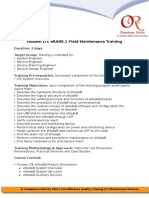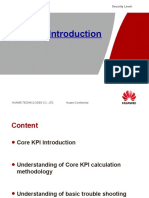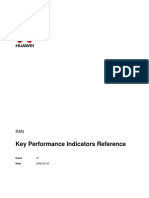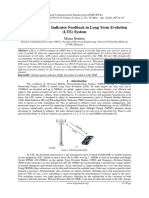KPI Formula 2G 3G
KPI Formula 2G 3G
Uploaded by
Tahitii ObiohaCopyright:
Available Formats
KPI Formula 2G 3G
KPI Formula 2G 3G
Uploaded by
Tahitii ObiohaCopyright
Available Formats
Share this document
Did you find this document useful?
Is this content inappropriate?
Copyright:
Available Formats
KPI Formula 2G 3G
KPI Formula 2G 3G
Uploaded by
Tahitii ObiohaCopyright:
Available Formats
3GPP TR 32.814 V7.0.
0 (2007-03)
Technical Report
3rd Generation Partnership Project;
Technical Specification Group Services and System Aspects;
Telecommunication management;
UTRAN and GERAN Key Performance Indicators (KPI)
(Release 7)
GLOBAL SYSTEM FOR
MOBILE COMMUNICATIONS
R
The present document has been developed within the 3
rd
Generation Partnership Project (3GPP
TM
) and may be further elaborated for the purposes of 3GPP.
The present document has not been subject to any approval process by the 3GPP
Organizational Partners and shall not be implemented.
This Specification is provided for future development work within 3GPP
only. The Organizational Partners accept no liability for any use of this Specification.
Specifications and reports for implementation of the 3GPP
TM
system should be obtained via the 3GPP Organizational Partners' Publications Offices.
3GPP
3GPP TR 32.814 V7.0.0 (2007-03) 2 Release 7
Keywords
GSM, UMTS, management, performance
3GPP
Postal address
3GPP support office address
650 Route des Lucioles - Sophia Antipolis
Valbonne - FRANCE
Tel.: +33 4 92 94 42 00 Fax: +33 4 93 65 47 16
Internet
http://www.3gpp.org
Copyright Notification
No part may be reproduced except as authorized by written permission.
The copyright and the foregoing restriction extend to reproduction in all media.
2007, 3GPP Organizational Partners (ARIB, ATIS, CCSA, ETSI, TTA, TTC).
All rights reserved.
3GPP
3GPP TR 32.814 V7.0.0 (2007-03) 3 Release 7
Contents
Foreword ............................................................................................................................................................. 4
Introduction ......................................................................................................................................................... 4
1 Scope ......................................................................................................................................................... 5
2 References ................................................................................................................................................. 5
3 Abbreviations ............................................................................................................................................ 6
4 CO-OP UTRAN KPI Definitions ............................................................................................................. 6
4.1 Overview of UTRAN KPIs and Categories ........................................................................................................ 6
4.2 KPI Types ............................................................................................................................................................ 6
4.3 RAB Establishment Success Rate ....................................................................................................................... 7
4.4 RRC Connection Establishment Success Rate .................................................................................................... 8
4.5 Call Setup Success Rate ...................................................................................................................................... 8
4.6 UTRAN initiated Iu connection drop rate ........................................................................................................... 9
4.7 Call Drop Rate ................................................................................................................................................... 10
4.8 Soft Handover Success Rate .............................................................................................................................. 11
4.9 Outgoing Hard Handover success rate .............................................................................................................. 12
4.10 Outgoing Inter RAT Handover success rate ...................................................................................................... 13
4.11 Throughput Measurements ................................................................................................................................ 14
5 CO-OP GERAN KPI Definitions ........................................................................................................... 15
5.1 Call Volume ....................................................................................................................................................... 15
5.2 Call Success Rate ............................................................................................................................................... 15
5.3 Call Drop Rate (Cell Level) ............................................................................................................................... 16
5.4 Handover Success Rate (BSC and Cell) ............................................................................................................ 17
5.5 Call Setup Success Rate .................................................................................................................................... 17
5.6 Assignment Procedure Success Rate ................................................................................................................. 18
5.7 SDCCH Blocking Rate ...................................................................................................................................... 19
5.8 TCH Blocking Rate ........................................................................................................................................... 19
5.9 TCH Traffic Carried .......................................................................................................................................... 19
6 High Level KPI Definitions .................................................................................................................... 20
6.1 Overview of UTRAN KPIs and Categories ...................................................................................................... 20
6.2 Call Drop Rate ................................................................................................................................................... 21
6.3 Cell Unavailability ............................................................................................................................................. 22
6.4 Uplink Block Error Rate .................................................................................................................................... 22
7 Template for definition of KPIs .............................................................................................................. 23
8 Conclusion .............................................................................................................................................. 24
Annex A: Change history ....................................................................................................................... 25
3GPP
3GPP TR 32.814 V7.0.0 (2007-03) 4 Release 7
Foreword
This Technical Report has been produced by the 3
rd
Generation Partnership Project (3GPP).
The contents of the present document are subject to continuing work within the TSG and may change following formal
TSG approval. Should the TSG modify the contents of the present document, it will be re-released by the TSG with an
identifying change of release date and an increase in version number as follows:
Version x.y.z
where:
x the first digit:
1 presented to TSG for information;
2 presented to TSG for approval;
3 or greater indicates TSG approved document under change control.
y the second digit is incremented for all changes of substance, i.e. technical enhancements, corrections,
updates, etc.
z the third digit is incremented when editorial only changes have been incorporated in the document.
Introduction
Cellular Networks are becoming more and more complex, with this complexity comes more services, and this in turn
leads to a greater number of network parameters that have to be tuned, optimised and made compatible. Cellular
Networks are also continuously evolving in terms of capacity and traffic patterns. To keep control of these very
dynamic networks, Operators need to keep a constant watch on network performance. Performance measurements are
collected by Network Elements throughout the network and 3GPP has defined many (hundreds) of standardized
measurements in the 52.402 and 32.4xx series specifications.
Typically Network Operators and equipment vendors will aggregate and combines some of the key measurements and
use them to compute some Key Performance Indicators (KPI). KPIs such as hand-off success rate, call drop-rate, hold
time, and congestion are continuously monitored to provide indicators of areas that might require tuning.
To date KPIs have not been standardised across equipment vendors, this makes it difficult for operators with multiple
vendors to easily calculate Network wide KPIs.
3GPP
3GPP TR 32.814 V7.0.0 (2007-03) 5 Release 7
1 Scope
The present document details a proposal to create Key Performance Indicators for UTRAN and GERAN networks,
using performance measurements defined in the 32.4xx series specifications (any exceptions are noted in the KPI
definitions).
The KPIs detailed in sections 4 & 5 are an output from the CO-OP initiative (A co-operative effort by eight network
equipment providers) [8].
The KPIs detailed in section 6 are an example of an alternative high level KPI definition method that does not rely on
standardised counter definitions. A draft KPI template is also described.
The KPI definitions in this Technical Report are intended as input to 3GPP for information and further study in the
possible creation of a 3GPP Technical Specification.
2 References
The following documents contain provisions which, through reference in this text, constitute provisions of the present
document.
References are either specific (identified by date of publication, edition number, version number, etc.) or
non-specific.
For a specific reference, subsequent revisions do not apply.
For a non-specific reference, the latest version applies. In the case of a reference to a 3GPP document (including
a GSM document), a non-specific reference implicitly refers to the latest version of that document in the same
Release as the present document.
[1] 3GPP TS 32.405, Telecommunication management; Performance Management (PM);
Performance measurements Universal Terrestrial Radio Access Network (UTRAN).
[2] 3GPP TS 25.331, Technical Specification Group, Radio Access Network; Radio Resource Control
(RRC); Protocol Specification (Release 6);
[3] 3GPP TS 25.413, Technical Specification Group, UTRAN Iu interface RANAP signalling
(Release 6);
[4] ETSI TS 102.250-2V1.2.1, Speech Processing, Transmission and Quality Aspects (STQ); QoS
aspects for popular services in GSM and 3G networks; Part 2: Definition of Quality of Service
parameters and their computation
[5] 3GPP TS 52.402, Telecommunication management; Performance Management (PM);
Performance measurements GSM (Release 6).
[6] 3GPP TR 21.905 Technical Specification Group Services and System Aspects; Vocabulary for
3GPP Specifications, Version 7.0.0.
[7] ITU-T Recommendation E.800; Terms and definitions related to quality of service and network
performance including dependability
[8] TMF 058 Supporting Document; 2G/3G Radio KPI Definitions, Release 2 version 2.0.1, March
2006.
3GPP
3GPP TR 32.814 V7.0.0 (2007-03) 6 Release 7
3 Abbreviations
For the purposes of the present document, the following abbreviations apply:
CO-OP A co-operative effort by eight network equipment providers [8]
CS Circuit Switched
EDGE Enhanced Data rates for GSM Evolution
GERAN GSM EDGE Radio Access Network
GSM Global System for Mobile Communications
KPI Key Performance Indicator
PS Packet Switched
RAB Radio Access Bearer
RAT Radio Access Technology
RRC Radio Resource Control
SDCCH Stand-alone Dedicated Control Channel
TCH Traffic Channel
UMTS Universal Mobile Telecommunications System
UTRAN UMTS Radio Access Network
4 CO-OP UTRAN KPI Definitions
The following clauses contain definitions of the UTRAN KPIs with an associated formula indicating how the KPI is
calculated from a set of component raw measurements. The definitions of the raw measurements used are given in [1].
4.1 Overview of UTRAN KPIs and Categories
The UTRAN KPIs described in this clause are categorized as follows:
Category KPI
UTRAN Circuit Switched (CS) Packet Switched (PS)
Accessibility RAB Estab. Success Rate CS RAB Estab. Success Rate PS
RRC Connection Establishment Success Rate
Call Setup Success Rate
Retainability Connection Drop Rate CS Connection Drop Rate PS
Call Drop Rate CS Call Drop Rate PS
Mobility Outgoing Hard Handover success rate
Outgoing Inter System Handover success rate CS Outgoing Inter System Handover success rate PS
Soft Handover Success Rate
Capacity Throughput Measurements CS Throughput Measurements PS
Some of the KPI categories (Accessibility & Retainability in the table above are service performance categories from
ITU-T Recommendation E.800 [7].
Any future KPI specification work should consider close alignment with ITU-T Recommendation E.800 [7].
4.2 KPI Types
The KPIs defined in this document are made up of three different KPI Types, i.e. Ratio, Mean and Cumulative. These
KPI types are indicated in the definitions by the keys RATIO, MEAN and CUM. The definitions of these KPI Types
are:
RATIO: This KPI is produced to reflect the percentage of a specific case occurrence to all the cases.
MEAN: This KPI is produced to reflect a mean measurement value based on a number of sample results.
CUM: This KPI is produced to reflect a cumulative measurement which is always increasing.
3GPP
3GPP TR 32.814 V7.0.0 (2007-03) 7 Release 7
4.3 RAB Establishment Success Rate
Long name a) RAB establishment success rate CS
b) RAB establishment success rate PS
c) RAB establishment success rate
Short name a) RabEstabSR.CS
b) RabEstabSR.PS
c) RabEstabSR
Description This KPI describes the ratio of all successful RAB establishments related to the total number of RAB
establishment attempts.
Formula
!
!
+
=
type
type
type AttEstabCS RAB
type SQueuing SuccEstabC RAB
type SNoQueuing SuccEstabC RAB
CS RabEstabSR
] .[ .
] .[ .
] .[ .
.
!
!
+
=
type
type
type AttEstabPS RAB
type SQueuing SuccEstabP RAB
type SNoQueuing SuccEstabP RAB
PS RabEstabSR
] .[ .
] .[ .
] .[ .
.
!
!
+
"
"
#
"
"
$
%
"
"
&
"
"
'
(
+
+
+
=
type
type
type AttEstabPS RAB type AttEstabCS RAB
type SQueuing SuccEstabP RAB
type SNoQueuing SuccEstabP RAB
type SQueuing SuccEstabC RAB
type SNoQueuing SuccEstabC RAB
RabEstabSR
] .[ . ] .[ .
] .[ .
] .[ .
] .[ .
] .[ .
type = ! {Conv, Strm, Intact, Bgrd}
Counters CS:
RAB.AttEstabCS.Conv, RAB.AttEstabCS.Strm, RAB.AttEstabCS.Intact, RAB.AttEstabCS.Bgrd
RAB.SuccEstabCSNoQueuing.Conv, RAB.SuccEstabCSQueuing.Conv,
RAB.SuccEstabCSNoQueuing.Strm, RAB.SuccEstabCSQueuing.Strm,
RAB.SuccEstabCSNoQueuing.Intact, RAB.SuccEstabCSQueuing.Intact,
RAB.SuccEstabCSNoQueuing.Bgrd, RAB.SuccEstabCSQueuing.Bgrd
PS:
RAB.AttEstabPS.Conv, RAB.AttEstabPS.Strm, RAB.AttEstabPS.Intact, RAB.AttEstabPS.Bgrd
RAB.SuccEstabPSNoQueuing.Conv, RAB.SuccEstabPSQueuing.Conv,
RAB.SuccEstabPSNoQueuing.Strm, RAB.SuccEstabPSQueuing.Strm,
RAB.SuccEstabPSNoQueuing.Intact, RAB.SuccEstabPSQueuing.Intact,
RAB.SuccEstabPSNoQueuing.Bgrd, RAB.SuccEstabPSQueuing.Bgrd
Object RncFunction
Unit/Range Range
Type RATIO
Remark ---
3GPP
3GPP TR 32.814 V7.0.0 (2007-03) 8 Release 7
4.4 RRC Connection Establishment Success Rate
Long name a) RRC connection establishment success rate
Short name a) RrcEstabSR
Description This KPI describes the ratio of successful RRC connection establishments related to the total number
of RRC connection establishment attempts.
Formula
!
!
=
cause
cause
cause ab AttConnEst RRC
cause tab SuccConnEs RRC
RrcEstabSR
] .[ .
] .[ .
The respective causes are detailed in 3GPP [2]
Counters RRC.AttConnEstab.Cause
RRC.SuccConnEstab.Cause
Object UtranCell
Unit/Range Range
Type RATIO
Remark The RRC Connection Attempts are excluding multiple repetitions of RRC Connection Attempts from
the same UE in order to correctly reflect the RRC Connection establishment rate from an UE
perspective. The RRC Connection Request to be considered in this KPI is the first RRC Connection
Request for a UE.
Note: It appears the counter definition for RRC connection establishment does include multiple attempts from the
same UE despite the remark above; A CR will be required to TS 32.405 to correct or add a new counter.
4.5 Call Setup Success Rate
Long name a) Call setup success rate
Short name a) CSSR
Description This KPI describes the ratio of successful call establishments. It is based on the Successful RRC
Connection Establishment Rate for call setup purposes and the RAB Establishment Success Rate for all
RAB types. Both KPIs are multiplied
Formula
!
!
!
"
#
$
$
$
%
&
=
'
'
cell cause
cell cause
cell cause ab AttConnEst RRC
cell cause tab SuccConnEs RRC
RabEstabSR CSSR
,
,
] , .[ .
] , .[ .
*
cause* =
Originating Conversational Call,
Originating Streaming Call,
Originating Interactive Call,
Originating Background Call,
Terminating Conversational Call,
Terminating Streaming Call,
Terminating Interactive Call,
Terminating Background Call
(only causes for call related in 3GPP 25.331)
Counters RabEstabSR (4.3)
RRC.AttConnEstab.Cause
RRC.SuccConnEstab.Cause
Object RNCFunction
Unit/Range Range
Type RATIO
Remark Since RRC counters are measured per cell object, the sum over all cells within one RNC needs to be
built, in order to get this rate on RNC level.
3GPP
3GPP TR 32.814 V7.0.0 (2007-03) 9 Release 7
4.6 UTRAN initiated Iu connection drop rate
Long name a) Iu Connection Drop rate CS
b) Iu Connection Drop rate PS
c) Iu Connection Drop rate
Short name a) IuConnDR.CS
b) IuConnDR.PS
c) IuConnDR
Description This KPI describes the ratio of abnormal UTRAN initiated Iu releases related to the total number of CN
initiated Iu releases.
Formula
!
!
=
cause
cause
cause RelCNCS IU.AttConn
cause NCS RelReqUTRA IU.AttConn
CS IuConnDR
] .[
*] .[
.
*
!
!
=
cause
cause
cause RelCNPS IU.AttConn
cause NPS RelReqUTRA IU.AttConn
PS IuConnDR
] .[
*] .[
.
*
!
!
"
#
$
%
&
' +
"
#
$
%
&
' +
=
cause
cause
cause RelCNPS IU.AttConn
cause RelCNCS IU.AttConn
cause NPS RelReqUTRA IU.AttConn
cause NCS RelReqUTRA IU.AttConn
IuConnDR
] .[
] .[
*] .[
*] .[
*
cause* = only causes for abnormal release; all causes are detailed in 3GPP 25.413
Counters CS:
IU.AttConnRelReqUTRANCS.cause, IU.AttConnRelCNCS.cause
PS:
IU.AttConnRelReqUTRANPS.cause, IU.AttConnRelCNPS.cause
Object RNCFunction
Unit/Range Range
Type RATIO
Remark This KPI reflects the user (UE) point of view, since the user may complain about a connection which is
released unexpectedly.
This KPI would be better if it could be based on counters for each Iu Interface ( i.e object = Iu Interface
rather than RNCFunction), The KPI may be updated in this respect if 3GPP counters per Iu Interface
become available ( This may be possible in 3GPP Release 7)
3GPP
3GPP TR 32.814 V7.0.0 (2007-03) 10 Release 7
4.7 Call Drop Rate
Long name a) Call drop rate CS
b) Call drop rate PS
c) Call drop rate
Short name a) CallDR.CS
b) CallDR.PS
c) CallDR
Description This KPI describes the ratio of RAB release requests related to the number of successful RAB
establishment (per CS/PS domain). Drops are derived from IU Release Request and RAB Release
Request messages sent from UTRAN to the CN.
Formula
!
!
+
+
=
type
cell
type SQueuing SuccEstabC RAB
type SNoQueuing SuccEstabC RAB
sum qCS l NbrIu RAB sum qCS l RAB
CS CallDR
] .[ .
] .[ .
. Re Re . . Re Re .
.
!
!
+
+
=
type
cell
type SQueuing SuccEstabP RAB
type SNoQueuing SuccEstabP RAB
sum qPS l NbrIu RAB sum qPS l RAB
PS CallDR
] .[ .
] .[ .
. Re Re . . Re Re .
.
!
!
!
"
"
#
"
"
$
%
"
"
&
"
"
'
(
+
+
+
+
+ +
=
type
cell
cell
type SQueuing SuccEstabP RAB
type SNoQueuing SuccEstabP RAB
type SQueuing SuccEstabC RAB
type SNoQueuing SuccEstabC RAB
sum qPS l NbrIu RAB sum qPS l RAB
sum qCS l NbrIu RAB sum qCS l RAB
CallDR
] .[ .
] .[ .
] .[ .
] .[ .
. Re Re . . Re Re .
. Re Re . . Re Re .
type = ! {Conv, Strm, Intact, Bgrd},
Counters CS:
RAB.SuccEstabCSNoQueuing.Conv
RAB.SuccEstabCSNoQueuing.Strm
RAB.SuccEstabCSNoQueuing.Intact
RAB.SuccEstabCSNoQueuing.Bgrd
RAB.SuccEstabCSQueuing.Conv
RAB.SuccEstabCSQueuing.Strm
RAB.SuccEstabCSQueuing.Intact
RAB.SuccEstabCSQueuing.Bgrd
RAB.RelReqCS.sum
RAB.NbrIuRelReqCS.sum
PS:
RAB.SuccEstabPSNoQueuing.Conv
RAB.SuccEstabPSNoQueuing.Strm
RAB.SuccEstabPSNoQueuing.Intact
RAB.SuccEstabPSNoQueuing.Bgrd
RAB.SuccEstabPSQueuing.Conv
RAB.SuccEstabPSQueuing.Strm
RAB.SuccEstabPSQueuing.Intact
RAB.SuccEstabPSQueuing.Bgrd
RAB.RelReqPS.sum
RAB.NbrIuRelReqPS.sum
Object RncFunction
Unit/Range Percent
Type RATIO
Remark Call drop rate reflects the retainability of communication as well as system reliability and stability; it is
a significant performance indicator.
3GPP
3GPP TR 32.814 V7.0.0 (2007-03) 11 Release 7
Radio system call drop rate only consider the drops caused from access side, not including the drops
caused by traffic overload, means those enforced drops demanded by RRM traffic control cannot be
taken into account.
Call drop rate can be divided into CS domain drop rate, PS domain drop rate and a total one.
4.8 Soft Handover Success Rate
Long name a) Radio link addition success rate
Short name a) RLAddSR
Description This KPI describes the ratio of successful radio link additions related to the total number of radio link
addition attempts.
Formula
a)
Side AttRLAddUE SHO
ESide SuccRLAddU SHO
RLAddSR
.
.
=
Counters SHO.SuccRLAddUESide
SHO.AttRLAddUESide
Object UtranCell
Unit/Range Range
Type RATIO
Remark Remark, the measured object is the cell, which has been added to the active link (set).
3GPP
3GPP TR 32.814 V7.0.0 (2007-03) 12 Release 7
4.9 Outgoing Hard Handover success rate
Long name a) Outgoing Hard Handover success rate (Intra Node B)
b) Outgoing Hard Handover success rate (Intra RNC)
c) Outgoing Hard Handover success rate (Inter RNC via Iur)
d) Outgoing Hard Handover success rate (Inter RNC CN)
e) Outgoing Hard Handover success rate
Short name a) HHOSR.IntraNB
b) HHOSR.IntraRNC
c) HHOSR.InterRNCviaIur
d) HHOSR.InterRNCCN
e) HHOSR
Description This KPI provides the ratio between successful outgoing hard handover related to the attempted
outgoing hard handover.
Formula
a)
aNodeB AttOutIntr HHO
raNodeB SuccOutInt HHO
IntraNB HHOSR
.
.
_ =
b)
aRNC rNodeBIntr AttOutInte HHO
raRNC erNodeBInt SuccOutInt HHO
IntraRNC HHOSR
.
.
_ =
c)
rRNCIur AttOutInte HHO
erRNCIur SuccOutInt HHO
r InterRNCIu HHOSR
.
.
_ =
d)
rRNCCN AttOutInte HHO
erRNCCN SuccOutInt HHO
InterRNCCN HHOSR
.
.
_ =
e)
!
!
"
!
!
#
$
!
!
%
!
!
&
'
+
+
+
!
!
"
!
!
#
$
!
!
%
!
!
&
'
+
+
+
=
rRNCCN AttOutInte HHO
rRNCIur AttOutInte HHO
aRNC rNodeBIntr AttOutInte HHO
aNodeB AttOutIntr HHO
erRNCCN SuccOutInt HHO
erRNCIur SuccOutInt HHO
raRNC erNodeBInt SuccOutInt HHO
raNodeB SuccOutInt HHO
HHOSR
.
.
.
.
.
.
.
.
Counters HHO.AttOutIntraNodeB, HHO.SuccOutIntraNodeB
HHO.AttOutInterNodeBIntraRNC, HHO.SuccOutInterNodeBIntraRNC
HHO.AttOutInterRNCIur, HHO.SuccOutInterRNCIur
HHO.AttOutInterRNCCN, HHO.SuccOutInterRNCCN
Object UtranCell (per neighbor cell relation)
Unit/Range Range
Type RATIO
Remark HHOSR.InterRNCIur and HHOSR.InterRNCCN is collected in the SRNC.
3GPP
3GPP TR 32.814 V7.0.0 (2007-03) 13 Release 7
4.10 Outgoing Inter RAT Handover success rate
Long name a) Outgoing Inter RAT Handover success rate (CS)
b) Outgoing Inter RAT Handover success rate (PS)
Short name a) IRATHOSR.CS
b) IRATHOSR.PS
Description This KPI indicates the overall hard handover inter RAT success rate towards GSM network (UMTS ->
GSM).
Formula
a)
epOutCS loc Att IRATHO
SuccOutCS IRATHO
CS IRATHOSR
Pr Re .
.
_ =
b)
RAN AttOutPSUT IRATHO
TRAN SuccOutPSU IRATHO
PS IRATHOSR
.
.
_ =
Counters CS:
IRATHO.AttRelocPrepOutCS, IRATHO.SuccOutCS
PS:
IRATHO.AttOutPSUTRAN, IRATHO.SuccOutPSUTRAN
Object UtranCelll (per neighbor cell relation)
Unit/Range Range
Type RATIO
Remark Measurements are collected in the SRNC.
Inter RAT handover for CS calls (UMTS -> GSM) starts from the relocation attempt.
Inter RAT handover for PS call (UMTS -> GPRS Cell Reselection, Network Initiated) considers only
the UTRAN controlled handover.
3GPP
3GPP TR 32.814 V7.0.0 (2007-03) 14 Release 7
4.11 Throughput Measurements
Long name Throuput on Iub-Interface
a) Mean User Data Throughput uplink on Iub interface (CS)
b) Mean User Data Throughput downlink on Iub interface (CS)
c) Mean User Data Throughput uplink on Iub interface (PS)
d) Mean User Data Throughput downlink on Iub interface (PS)
Throuput on Iu-Interface
e) Mean User Data Throughput uplink on IuCS interface
f) Mean User Data Throughput downlink on IuCS interface
g) Mean User Data Throughput uplink on IuPS interface
h) Mean User Data Throughput downlink on IuPS interface
Short name a) MeanUserDataULIub.CS
b) MeanUserDataDLIub.CS
c) MeanUserDataULIub.PS
d) MeanUserDataDLIub.PS
e) MeanUserDataULIuCS
f) MeanUserDataDLIuCS
g) MeanUserDataULIubPS
h) MeanUserDataDLIubPS
Description This indicator is an estimation of the mean user data throughput on dedicated channels in kbit per
second per cell on the Iub interface in the uplink/downlink direction.
Formula
a) 1000 / 8 * ]) ][ .([ . . CS UL hput UserThroug Iub CS taULIub MeanUserDa =
b) 1000 / 8 * ]) ][ .([ . . CS DL hput UserThroug Iub CS taDLIub MeanUserDa =
c) 1000 / 8 * ]) ][ .([ . . PS UL hput UserThroug Iub PS taULIub MeanUserDa =
d) 1000 / 8 * ]) ][ .([ . . PS DL hput UserThroug Iub PS taDLIub MeanUserDa =
e) 1000 / 8 * ]) .([ . UL hput UserThroug IuCS taULIuCS MeanUserDa =
f) 1000 / 8 * ]) .([DL roughput IuCSUserTh taDLIuCS MeanUserDa =
g) 1000 / 8 * ]) .([UL roughput IuPSUserTh taULIubPS MeanUserDa =
h) 1000 / 8 * ]) ][ .([ . PS DL hput UserThroug IuPS taDLIuPS MeanUserDa =
Counters Iub.UserThroughput,
IuCS.UserThroughput,
IuPS.UserThroughput
Trigger = Transmission/reception RLC PDU octets on Iub
Object Iub: NodeB,
Iur: RncFunction
Unit/Range kbit/sec
Type CUM
Remark There are no standardized counters which provide the mean user data throughput on dedicated
channels on Iu, Iub interface per UL/DL direction and per CS/PS domain.
3GPP
3GPP TR 32.814 V7.0.0 (2007-03) 15 Release 7
5 CO-OP GERAN KPI Definitions
The following clause contains a definition of the GERAN KPIs with an associated formula indicating how the KPI is
calculated from a set of component raw measurements, further definition of the raw measurements used is given in
TS 52.402 [5].
5.1 Call Volume
Long name: Call Volume
Short name:
Description: This formula calculates the number of call originations which successfully access a TCH.
Formula:
( ) ingRate SDCCHBlock zures succTCHSei CallVolume ! " = 1
Counter: 3GPP 52.402:
a) succTCHSeizures
b) SDCCHBlockingRate
Elem. Object: CELL
Unit: Calls
Type: CUM
Remarks: See below for SDCCHBlockingRate KPI definition
5.2 Call Success Rate
Long name: a) Call Success Rate
Short name: a) CSR
Description: Single overall figure for network quality from a subscribers perspective which represents the
proportion of calls which complete successfully i.e. Set-Up successfully and do not suffer an RF loss
before user termination or successful hand out.
Formula:
!
"
#
$
%
&
' ( =
100
1
te CallDropRa
uccessRate CallSetupS sRate CallSucces
Counter: Call Setup Success Rate see definition below.
Call Drop Rate see definition below.
Elem. Object: CELL
Unit: Percent
Type: RATIO
Remarks: Please refer to KPI definitions for Call Setup Success Rate and Drop Call Rate below.
3GPP
3GPP TR 32.814 V7.0.0 (2007-03) 16 Release 7
5.3 Call Drop Rate (Cell Level)
Long name: a) Call Drop Rate
Short name:
Description: This formula calculates the proportion of mobiles which, having successfully accessed the TCH,
subsequently suffer an abnormal release, caused by loss of the radio link. This figure is comprised of
RF Losses on the TCH plus losses during handover.
Formula:
!
!
"
#
$
$
%
&
+
+
!
!
!
!
!
"
#
$
$
$
$
$
%
&
+
+
+
=
DOs InterCellH ngInternal succIncomi
aCell alHDOsIntr succIntern zures succTCHSei
Connection WithLossOf unsuccHDOs
connection With unsuccHDOs
traCell rnalHDOsIn unsuccInte
CH adioLinksT nbrOfLostR
teCell CallDropRa
Re
Counter: 3GPP 52.402:
a) nbrOfLostRadioLinksTCH
b) unsuccInternalHDOsIntraCell
c) unsuccHDOsWithReconnection
d) unsuccHDOsWithLossOfConnection
e) succTCH seizures
f) succInternalHDOsIntraCell
g) succIncomingInternalInterCellHDOs
Elem. Object: CELL
Unit: Percent
Type: RATIO
Remarks:
3GPP
3GPP TR 32.814 V7.0.0 (2007-03) 17 Release 7
5.4 Handover Success Rate (BSC and Cell)
Long name: a) Handover Success Rate
Short name:
Description: The HANDOVER_SUCCESS_RATE statistic tracks the percent of handovers that were attempted from
the source cell (cell for which the statistic is presented) that succeeded in making it to the destination
cell.
Formula:
(
)
!
!
!
!
"
#
$
$
$
$
%
&
'
+ +
=
% 100
Re
rBSC nnectionPe thLossOfCo rnalHDOsWi unsuccInte
PerBSC connection th rnalHDOsWi unsuccInte SC alHDOsPerB succIntern
SC alHDOsPerB succIntern
sc ccessRateB HandoverSu
!
!
"
#
$
$
%
&
=
Os nterCellHD gInternalI attOutgoin
DOs InterCellH ngInternal succOutgoi
ell ccessRateC HandoverSu
Counter: 3GPP 52.402
BSC Handover Success Rate
a) succInternalHDOsPerBSC
b) unsuccInternalHDOsWithReconnectionPerBSC
c) unsuccInternalHDOsWithLossOfConnectionPerBSC
Cell Handover Success Rate
a) succOutgoingInternalInterCellHDOs
b) attOutgoingInternalInterCellHDOs
Elem. Object: BSC, CELL
Unit: Percent
Type: RATIO
Remarks:
5.5 Call Setup Success Rate
Long name: a) Call Setup Success Rate
Short name:
Description: This formula calculates the proportion of mobiles which successfully access a TCH.
Formula:
ures attTCHSeiz
zures succTCHSei
uccessRate CallSetupS =
Counter: 3GPP 52.402:
a) succTCHSeizures
b) attTCHseizures
Elem. Object: CELL
Unit: Percent
Type: RATIO
Remarks:
3GPP
3GPP TR 32.814 V7.0.0 (2007-03) 18 Release 7
5.6 Assignment Procedure Success Rate
Long name: Assignment Procedure Success Rate
Short name:
Description: This formula calculates the proportion of mobiles which successfully access to resources, having
requested an appropriate service on accessing the SDCCH.
Formula: Formula
ocsPerBSC teAssingPr attImmedia
SC alHDOsPerB succIntern
rocsPerBSC ateAssingP succImmedi
SuccRate AssignProc
!
!
"
#
$
$
%
& +
=
Counter: 3GPP 52.402:
a) succImmediateAssingProcsPerBSC
b) succInternalHDOsPerBSC
c) attImmediateAssingProcsPerBSC
Elem.
Object:
BSC
Unit: Percent
Type: RATIO
Remarks:
3GPP
3GPP TR 32.814 V7.0.0 (2007-03) 19 Release 7
5.7 SDCCH Blocking Rate
Long name: a) SDCCH Blocking Rate
Short name:
Description: This formula calculates the proportion of all SDCCH resource requests and failed due to no SDCCH
resource available.
Formula:
rocs ateAssingP succImmedi
ockedState ingSDCCHBl izuresMeet attSDCCHSe
ingRate SDCCHBlock =
Counter: 3GPP 52.402:
a) attSDCCHSeizuresMeetingSDCCHBlockedState
b) succImmediateAssingProcs
Elem.
Object:
CELL
Unit: Percent
Type RATIO
Remarks:
5.8 TCH Blocking Rate
Long name: a) TCH Blocking Rate
Short name:
Description: This formula calculates the proportion of all requests for TCH resources (call origination and incoming
handover) and fail due non available TCH resources.
Formula:
ures attTCHSeiz
dState gTCHBlocke uresMeetin attTCHSeiz
gRate TCHBlockin =
Counter: 3GPP 52.402:
a) attTCHSeizuresMeetingTCHBlockedState
b) succTCHSeizures
Elem.
Object:
CELL
Unit: Percent
Type: RATIO
Remarks:
5.9 TCH Traffic Carried
Long name: a) TCH Traffic Carried
Short name:
Description: This KPI provides the arithmetic mean number of Time slots which are simultaneously in use for
Circuit Switched traffic (TCHs)
Formula:
usyTCHs meanNbrOfB Carried TCHTraffic =
Counter: 3GPP 52.402:
a) meanNbrOfBusyTCHs
Elem. Object: CELL
Unit: TCH
Type: MEAN
Remarks:
3GPP
3GPP TR 32.814 V7.0.0 (2007-03) 20 Release 7
6 High Level KPI Definitions
For some KPIs, even if the KPI definition could be common across equipment vendors and network operators, the
related calculation formulas and the Network Elements raw counters may not be. It is different between vendors, and
can change over time as the Network Elements or the technologies evolve. 3GPP specifications allow different
implementation alternatives that consequently lead to non uniform counter updates or even different counter definitions
between vendors. Such High Level KPIs should be well described, including a clear rationale, but the details about
which measurements (counters) or formulas to use should not be standardized.
Subsection 6.1 gives an overview of example UTRAN KPIs and categories that are further detailed in sections 6.2-6.4.
6.1 Overview of UTRAN KPIs and Categories
The UTRAN KPIs described in this clause are categorized as follows:
Category KPI
Retainability Call Drop Rate
Availability Cell Unavailability
Integrity UL BLER (Uplink Block Error Rate)
Additionally, the KPIs can be sub-categorized based on RAB types. Which RAB types to use should be vendor-specific.
The KPI categories in the table above are service performance categories from ITU-T Recommendation E.800 [7].
Any future KPI specification work should consider close alignment with ITU-T Recommendation E.800 [7].
3GPP
3GPP TR 32.814 V7.0.0 (2007-03) 21 Release 7
6.2 Call Drop Rate
Long name a) Call drop rate CS RABtype1
b) Call drop rate CS.RABtype2
c) Call drop rate CS RABTypeN
..
Short name
a) CallDR.CS.RABtype1
b) CallDR.CS.RABtype2
c) CallDR.CS.RABtypeN
Description This KPI describes the ratio of abnormal RAB releases related to the total number of RAB releases.
Abnormal RAB releases are all RAB releases not initiated by the user or the application.
Rational Call drop rate reflects the retainability of communication as well as system reliability and stability; it
is a significant performance indicator.
Definition The Call Drop Rate is the ratio of the number of abnormal RAB releases (for a certain RAB type)
related to the total number of RAB releases (for a certain RAB type).
Counters Not specified.
Reason: The counters can be vendor specific.
Object UtranCell/RncFunction
Unit/Range Percent
Type RATIO
Remark RABtype is Conv, Strm etc.
Note: High level defintion of Call to be added
3GPP
3GPP TR 32.814 V7.0.0 (2007-03) 22 Release 7
6.3 Cell Unavailability
Long name Cell Unavailability
Short name CellUnavailability
Description This KPI describes the unavailability of the cell as perceived by the end-user.
Rationale This KPI gives the operator the end-user perception of the availability of a cell.
Definition Cell Unavailability is the ratio of the time when a cell is out of service (not caused by operator
interference) related to a specified measurement time interval.
Counters Not specified.
Reason: The counters can be vendor specific, or the unavailability can be caused by e.g. a hardware
fault.
Object UtranCell
Unit/Range Percent
Type RATIO
Remark .
Note: High level defintion of cell out of service to be added
6.4 Uplink Block Error Rate
Long name Uplink Block Error Rate
Short name ULBLER
Description This KPI describes the Uplink Block Error Rate.
Rationale This KPI gives the operator an indication of the Uplink Block Error Rate (UL BLER, 3GPP TS
25.423).
The UL BLER can be mapped on the perceived speech quality.
Definition Uplink Block Error Rate is the ratio of the number of faulty UL transport blocks in relation to the total
number of UL transport blocks.
Counters Not specified.
Reason: the counters can be vendor specific.
Object UtranCell
Unit/Range Percent
Type RATIO
Remark -
3GPP
3GPP TR 32.814 V7.0.0 (2007-03) 23 Release 7
7 Template for definition of KPIs
This section contains the KPI definition template that has been used for the KPIs defined in section 6.
Long name
(mandatory)
a)
b)
c)
..
Short name
(mandatory)
a)
b)
c)
..
Description
(mandatory)
Rationale
(mandatory)
Definition
(mandatory)
a) (formula)
b) (formula)
c) (formula)
(if no formulas are specified, a verbal definition of the KPI should be given here)
Counters
(optional)
(if no counters are specified, a reason for that can be given here)
Object
(mandatory)
Unit/Range
(mandatory)
Type
(mandatory)
RATIO / MEAN / CUM
Remark
(optional)
3GPP
3GPP TR 32.814 V7.0.0 (2007-03) 24 Release 7
8 Conclusion
This present document by way of examples has detailed two methods of defining Key Performance Indicators (KPIs),
the first method (sections 4 and 5) is characterised by using performance measurements defined in the 32.4xx series
specifications, the second method takes a higher level approach that does not require the use of standardised
performance measurements.
This study concludes that where standardised measurements are available, the first definition approach should be used,
however when standardised measurements are not available or not appropriate to use, e.g. when differing
implementation alternatives have led to non uniform counter updates or even different counter definitions between
vendors, then a higher level KPI definition approach as detailed in section 6 may be used.
Note: This study has not used a uniform template between the two different KPI methods, this is something that should
be addressed in any future KPI standardisation work.
3GPP
3GPP TR 32.814 V7.0.0 (2007-03) 25 Release 7
Annex A:
Change history
Change history
Date TSG # TSG Doc. CR Rev Subject/Comment Cat Old New
Dec 2006 SA_34 SP-060738 -- -- Submitted to SA#34 for Information -- 1.0.0
Mar 2007 SA_35 SP-070050 -- -- Submitted to SA#35 for Approval -- 2.0.0 7.0.0
You might also like
- Huawei LTE ERAN8.1 Field Maintenance TrainingDocument2 pagesHuawei LTE ERAN8.1 Field Maintenance TrainingVikas KhantwalNo ratings yet
- Regulators QoS Approach ITU T.E800 (Highlights)Document32 pagesRegulators QoS Approach ITU T.E800 (Highlights)Tahitii ObiohaNo ratings yet
- The Issue of Dwell Time Charges To Optimize Container Terminal CapacityDocument21 pagesThe Issue of Dwell Time Charges To Optimize Container Terminal CapacityAnonymous 3tf6k3alrQ50% (2)
- Eclipse Odu 300 RF Unit: Ansi DatasheetDocument2 pagesEclipse Odu 300 RF Unit: Ansi DatasheetmosaababbasNo ratings yet
- 3GPP TR 32.814Document25 pages3GPP TR 32.814Mohamed Abdel MonemNo ratings yet
- KPIs in Actix Guide Book-0118Document131 pagesKPIs in Actix Guide Book-0118Chitranjan KumarNo ratings yet
- Huawei ERAN6 0 KPI IntroductionDocument57 pagesHuawei ERAN6 0 KPI IntroductionPedro_1976100% (2)
- 3GPP ReleaseDocument149 pages3GPP ReleaseAjay Vachhani100% (1)
- GSM Network Optimization Express-Kpi Pocket Book v1 PDFDocument49 pagesGSM Network Optimization Express-Kpi Pocket Book v1 PDFlteuserNo ratings yet
- 3GPP TS 32.450: Technical SpecificationDocument17 pages3GPP TS 32.450: Technical SpecificationTom NguyenNo ratings yet
- 3gpp Kpi Umts GSMDocument29 pages3gpp Kpi Umts GSMunclewuNo ratings yet
- 2G KPI FormulaDocument9 pages2G KPI Formulanishantha041No ratings yet
- Performance ManagementDocument92 pagesPerformance ManagementJoel Rayala100% (1)
- XCAL ProductDescription 20100907Document75 pagesXCAL ProductDescription 20100907Jitender ThakurNo ratings yet
- 05-TD-LTE KPI Introduction-63Document63 pages05-TD-LTE KPI Introduction-63Neeraj Mittal50% (2)
- XCAL User GuideDocument22 pagesXCAL User GuideRF Optimization100% (2)
- HSDPA - HSUPA Throughput CalculationDocument2 pagesHSDPA - HSUPA Throughput CalculationRudy Setiawan100% (1)
- KPI PresentationDocument17 pagesKPI PresentationVikas GargNo ratings yet
- LTE FDD RF Optimization Methods & ProceduresDocument225 pagesLTE FDD RF Optimization Methods & ProceduresHtet Aung LynnNo ratings yet
- Troubleshooting of 3G KPIDocument134 pagesTroubleshooting of 3G KPIankurverma1987No ratings yet
- PDP Context Activation GuideDocument124 pagesPDP Context Activation GuideUmar Abbas BabarNo ratings yet
- Lte Kpi PDFDocument11 pagesLte Kpi PDFNguyen Thanh VuNo ratings yet
- CQIDocument10 pagesCQIsohappy2No ratings yet
- Cluster Optimization Analysis: Security Level: InternalDocument65 pagesCluster Optimization Analysis: Security Level: InternalAbdoulaye AbakarNo ratings yet
- Xcal-Mobile Release Note v4 5 XX - Rev3 - 130620Document37 pagesXcal-Mobile Release Note v4 5 XX - Rev3 - 130620Phong TaNo ratings yet
- RAN Key Performance Indicators Reference (RAN10.0 - 01)Document77 pagesRAN Key Performance Indicators Reference (RAN10.0 - 01)Bipin TiwariNo ratings yet
- KPIDocument5 pagesKPIGaurav MishraNo ratings yet
- LTE Advanced - Carrier Aggregation - ShareTechnoteDocument18 pagesLTE Advanced - Carrier Aggregation - ShareTechnoteGanesh JadhavNo ratings yet
- 2G KpiDocument61 pages2G Kpirachid190274No ratings yet
- LTE FDD Cluster DT - Analysis ReportDocument23 pagesLTE FDD Cluster DT - Analysis ReportAnonymous 0d9mC0OaxENo ratings yet
- IMS KPIsDocument14 pagesIMS KPIsTuan NguyenNo ratings yet
- What Is 3GPPDocument319 pagesWhat Is 3GPPAli Nasutionypttr yiu yfrfijjbvvht5No ratings yet
- Sina Institute of Networks & Aesthetics: 4G Lte Credit Hours: 48 Content DetailsDocument1 pageSina Institute of Networks & Aesthetics: 4G Lte Credit Hours: 48 Content DetailsSaad FarhanNo ratings yet
- Signal Perameters (RSSI, RSRQ & SINR in LTE)Document4 pagesSignal Perameters (RSSI, RSRQ & SINR in LTE)Usman NomaniNo ratings yet
- 5 Network Wide KPI's (NBH) : Share ThisDocument5 pages5 Network Wide KPI's (NBH) : Share ThisPraveen KumarNo ratings yet
- RF Optimization EngineerDocument7 pagesRF Optimization EngineerRamya KrishnaNo ratings yet
- GSM Bss Swap GuideDocument112 pagesGSM Bss Swap GuideJackson A. Plus100% (1)
- 04 Performance Monitoring PDFDocument41 pages04 Performance Monitoring PDFgh_jazaniNo ratings yet
- Umts Radio Network KpiDocument49 pagesUmts Radio Network KpisirnateNo ratings yet
- LTE-SAE A System Overview - RoDocument110 pagesLTE-SAE A System Overview - RoFlorin NituNo ratings yet
- SPD LTE RF Channel Troubleshooting Guide 20120718 A 1 0Document44 pagesSPD LTE RF Channel Troubleshooting Guide 20120718 A 1 0Ahmed GamalNo ratings yet
- Huawei EUTRAN COunters and MODocument18 pagesHuawei EUTRAN COunters and MOhgamhgamNo ratings yet
- Call Fail Analysis GuidelineDocument20 pagesCall Fail Analysis Guidelineferrya79No ratings yet
- Lte Kpis Are Classified Into 7 Type:: 1-Accessibility KpiDocument2 pagesLte Kpis Are Classified Into 7 Type:: 1-Accessibility KpiBromand TurkmaniNo ratings yet
- 32455-A00 - Telecommunication Management Key Performance Indicators (KPI) For The Evolved Packet Core (EPC) DefinitionsDocument15 pages32455-A00 - Telecommunication Management Key Performance Indicators (KPI) For The Evolved Packet Core (EPC) DefinitionsBimal JhariatNo ratings yet
- Wcdma KpiDocument31 pagesWcdma Kpimr_hemel2386No ratings yet
- 08 Lte KpiDocument15 pages08 Lte KpiEko MardiantoNo ratings yet
- 2G - 3G - Sunset Guideline - 03 - 06 - 21Document19 pages2G - 3G - Sunset Guideline - 03 - 06 - 21Георгий МоканNo ratings yet
- 4.5G Capacity & Qos Optimization: A New Proposal To Enhance The Principal Kpis of 5G/IotDocument9 pages4.5G Capacity & Qos Optimization: A New Proposal To Enhance The Principal Kpis of 5G/IothushhamNo ratings yet
- ! ANITE Guideline - RF Tuning by Measurements V2 - 0Document146 pages! ANITE Guideline - RF Tuning by Measurements V2 - 0Predrag RadicNo ratings yet
- 26.wo - Na08 - E1 - 1 Umts Radio Network Kpi-108Document107 pages26.wo - Na08 - E1 - 1 Umts Radio Network Kpi-108Tri NguyenNo ratings yet
- ReportdDocument532 pagesReportdJosh666No ratings yet
- Gaurav Chauhan RF Optimization & Planing Wcdma Lte NetworkDocument6 pagesGaurav Chauhan RF Optimization & Planing Wcdma Lte NetworkSahoo SKNo ratings yet
- Throughput Problem Log Collection Guide - 7.0Document28 pagesThroughput Problem Log Collection Guide - 7.0Mohammad KamruzzamanNo ratings yet
- Ran Kpi ReferenceDocument120 pagesRan Kpi ReferenceSamiNo ratings yet
- Cause Code MappinDocument114 pagesCause Code MappinVivek AgrahariNo ratings yet
- GPRS For 2 Hours TrainingDocument105 pagesGPRS For 2 Hours Trainingh_hadidiNo ratings yet
- 4G Optimization and KPI Analysis - Telecom HubDocument7 pages4G Optimization and KPI Analysis - Telecom HubAymen Ben zinebNo ratings yet
- VoLTE and ViLTE: Voice and Conversational Video Services over the 4G Mobile NetworkFrom EverandVoLTE and ViLTE: Voice and Conversational Video Services over the 4G Mobile NetworkNo ratings yet
- T Rec E.840 201806 I!!pdf eDocument22 pagesT Rec E.840 201806 I!!pdf eTahitii ObiohaNo ratings yet
- Qoe by HuaweiDocument54 pagesQoe by HuaweiTahitii ObiohaNo ratings yet
- Ujcn5 12701312Document8 pagesUjcn5 12701312belhadj39No ratings yet
- Case Study: Highlights OrganizationDocument2 pagesCase Study: Highlights OrganizationTahitii ObiohaNo ratings yet
- CSSR LTEEvalauationDocument6 pagesCSSR LTEEvalauationTahitii ObiohaNo ratings yet
- OpenSignal Insights Report SampleDocument109 pagesOpenSignal Insights Report SampleTahitii ObiohaNo ratings yet
- Training Catalogue 2015 - V4 PDFDocument46 pagesTraining Catalogue 2015 - V4 PDFTahitii Obioha100% (1)
- Côte D'ivoire Profile (Latest Data Available: 2013)Document3 pagesCôte D'ivoire Profile (Latest Data Available: 2013)Tahitii ObiohaNo ratings yet
- Huawei DBS3900 Commissioning MOP - V1 - 2 20090515Document30 pagesHuawei DBS3900 Commissioning MOP - V1 - 2 20090515yetunde77100% (5)
- Huawei Esight Brief Product Brochure (05-Sept-2013)Document8 pagesHuawei Esight Brief Product Brochure (05-Sept-2013)Tahitii ObiohaNo ratings yet
- QOS BkgpaperDocument57 pagesQOS BkgpaperTahitii ObiohaNo ratings yet
- Ethernet Packet Rate and Throughput Calculations - Ciena CommunityDocument8 pagesEthernet Packet Rate and Throughput Calculations - Ciena Communityy_m_algbaliNo ratings yet
- Second-Generation E-Band Solutions: Opportunities For Carrier-Class LTE BackhaulDocument0 pagesSecond-Generation E-Band Solutions: Opportunities For Carrier-Class LTE BackhaulsombatseNo ratings yet
- Mitigating Congestion in Wireless Sensor NetworksDocument14 pagesMitigating Congestion in Wireless Sensor NetworksIglesia RestauracionNo ratings yet
- Nemo Analyze KPI ListDocument89 pagesNemo Analyze KPI ListJames CagaraNo ratings yet
- Vienna 5G System Level Simulator v1.0 - List of Features: General FunctionalityDocument2 pagesVienna 5G System Level Simulator v1.0 - List of Features: General FunctionalityGraça Sousa MendesNo ratings yet
- RTN 950A Performance Event ListDocument36 pagesRTN 950A Performance Event ListAmir VahidiNo ratings yet
- Userspace Drivers in LinuxDocument4 pagesUserspace Drivers in LinuxJeffi Edward100% (1)
- 【Output】RRU Abnormal Caused Low throughput issueDocument10 pages【Output】RRU Abnormal Caused Low throughput issueBrahim YEKHLEFNo ratings yet
- A Minimum Cost Design For An Automated WarehouseDocument284 pagesA Minimum Cost Design For An Automated Warehousekutsay100% (1)
- Poster: Frame Aggregation in 802.11ac: Need For Modified Block ACKDocument3 pagesPoster: Frame Aggregation in 802.11ac: Need For Modified Block ACKHusseinJafarTayarNo ratings yet
- Lte Counters2Document4 pagesLte Counters2ZARA FARPIERNo ratings yet
- RSA NetWitness Scenario Planner v11.3.11.2019Document284 pagesRSA NetWitness Scenario Planner v11.3.11.2019Pentest Prometheus100% (1)
- Channel Quality Indicator Feedback in Long Term Evolution (LTE) SystemDocument6 pagesChannel Quality Indicator Feedback in Long Term Evolution (LTE) SystemMED MOHNo ratings yet
- Multi-Channel MAC For Ad Hoc NetworksDocument54 pagesMulti-Channel MAC For Ad Hoc NetworksHassan HassanNo ratings yet
- Analysis of Performance Bottlenecks in Soc Interconnect SubsystemsDocument4 pagesAnalysis of Performance Bottlenecks in Soc Interconnect SubsystemsMOHAMMAD AWAISNo ratings yet
- Process and Variability: Operations Management (OM) TriangleDocument19 pagesProcess and Variability: Operations Management (OM) TriangleSahil ParekhNo ratings yet
- Uplink Coordinated Scheduling (ERAN12.1 - 04)Document63 pagesUplink Coordinated Scheduling (ERAN12.1 - 04)waelq2003No ratings yet
- Interference Constrained Device-to-Device CommunicationsDocument6 pagesInterference Constrained Device-to-Device CommunicationsAmjedNo ratings yet
- Computer Networks and Management: Integrated and Differentiated ServicesDocument51 pagesComputer Networks and Management: Integrated and Differentiated ServicesVenkatakrishnan NatchiappanNo ratings yet
- Chapter1 2010fallDocument76 pagesChapter1 2010fallTerence IpNo ratings yet
- D2D Communication Presentation Mod4Document39 pagesD2D Communication Presentation Mod4Mai AwadNo ratings yet
- Radware DefensePro SpectDocument6 pagesRadware DefensePro SpectCes LeonNo ratings yet
- BSC6900 Configuration Principle (Global) (V900R015C00 - 09) (PDF) - enDocument113 pagesBSC6900 Configuration Principle (Global) (V900R015C00 - 09) (PDF) - enSudheera Indrajith100% (2)
- LTE Uplink Throughput TroubleshootingDocument4 pagesLTE Uplink Throughput TroubleshootingsumantabhuinNo ratings yet
- 3gpp Ts 36 104 (Lte Enb TX and RX)Document117 pages3gpp Ts 36 104 (Lte Enb TX and RX)delafinca55No ratings yet
- Engineering Analysis of Storage SystemsDocument5 pagesEngineering Analysis of Storage SystemsIvett LunaNo ratings yet
- Virtual Speed Test: An Ap Tool For Passive Analysis of Wireless LansDocument9 pagesVirtual Speed Test: An Ap Tool For Passive Analysis of Wireless LansPeshal NayakNo ratings yet
- Federated Learning: Collaborative Machine Learning Without Centralized Training Data at Google Research BlogDocument26 pagesFederated Learning: Collaborative Machine Learning Without Centralized Training Data at Google Research BlogRam Prasad Reddy SadiNo ratings yet





































































































